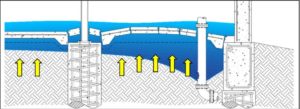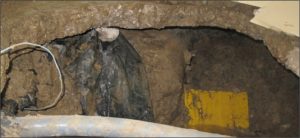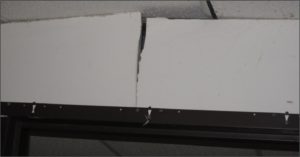While thankfully not common, below-grade fire riser plumbing failures can cause significant damages to buildings. These failures are characterized by high-pressure water leakage, often resulting in significant amounts of moisture leaking beneath the foundation in a relatively short period of time. Therefore, damage from a fire riser failure typically manifests due to three primary mechanisms: hydrostatic pressure, soil erosion, and/or volumetric changes in the underlying soils.
For slab-on-grade foundations, the pressure from the water often results in upward deflection and fractures in the top surface of the slab, as represented in Figure 1. The high pressure of the water leakage also displaces soil beneath the slab, with the erosion potentially resulting in voids beneath the slab once the water has dissipated (Figure 2).

Figure 1: Representative view of the upward force (shown with yellow arrows) resulting from the fire riser rupture

Figure 2: Visible void below the concrete slab adjacent to the fire riser
For structures with underlying expansive soils, the effect of introducing a large volume of water to the subgrade should also be considered, although the relatively quick mitigation of the excess moisture may prevent significant soil expansion effects on a structure.
Investigation of fire riser failures includes observations of not only the conditions at the foundation, but also at the framing and finishes at walls and ceilings above the floor level. Distress such as fractures at the gypsum board wall finishes (Figure 3), displaced and deformed ceiling grids, and buckled floor finishes are consistent with vertical displacement of the foundation slab from a fire riser failure.

Figure 3: Wall and ceiling distress in close proximity to the fire riser
In addition to visual evaluation, the investigation of fire riser failures may include testing, such as an elevation survey of the foundation system, the use of ground-penetrating radar to detect voids, and exploratory testing to provide direct observation of the conditions beneath the foundation slab.
Nelson’s team of professionals is well versed in evaluating structures that have been subjected to fire riser failures and other plumbing failures, and has evaluated thousands of structure foundations. For additional information on the topic of the investigation of fire riser failures, please click HERE to review the technical paper authored by Nelson professionals Trevor Greenberg, P.E. and Travis Ebisch, P.E., which was presented at the 2022 ASCE Congress on Forensic Engineering in Denver and was published with the conference proceedings.

